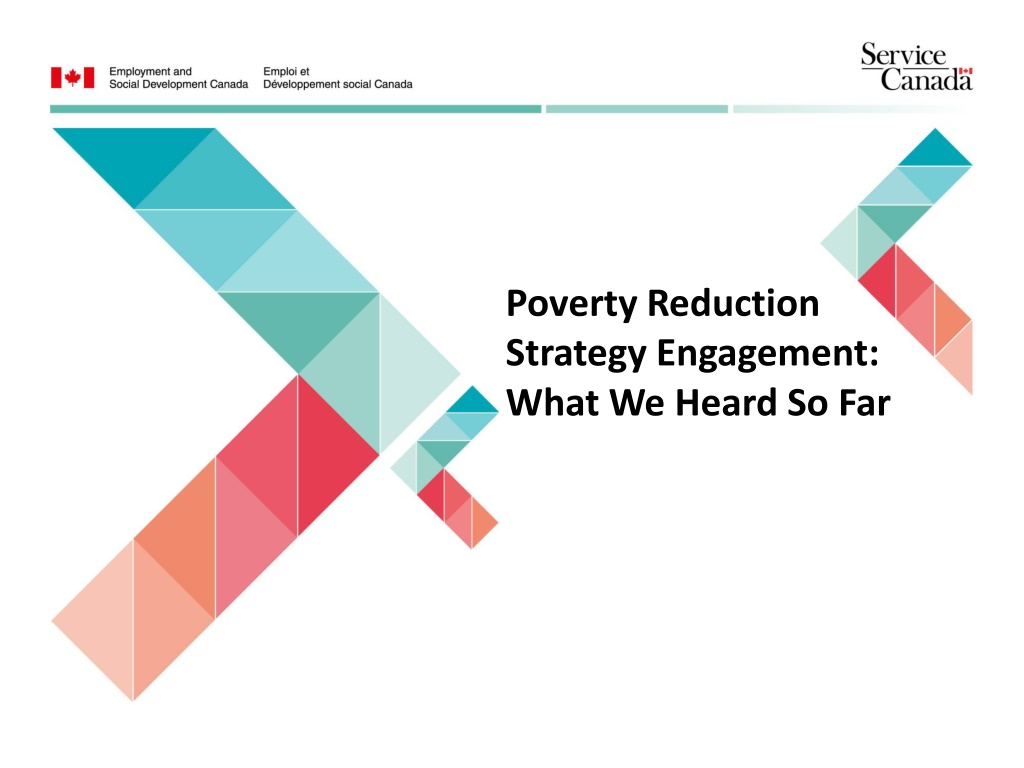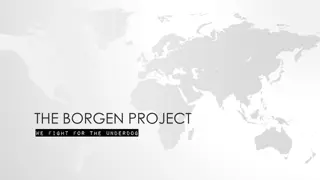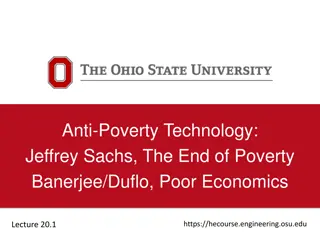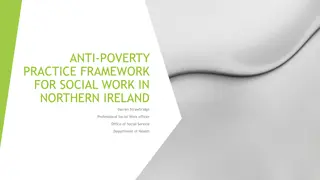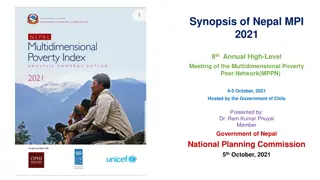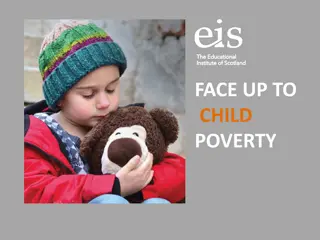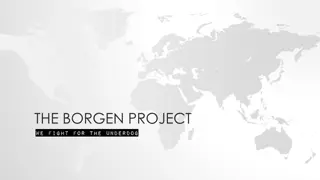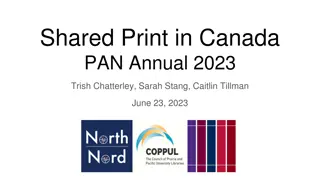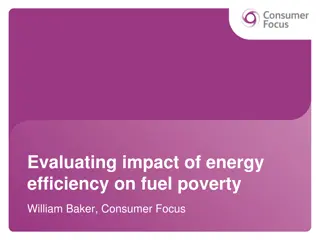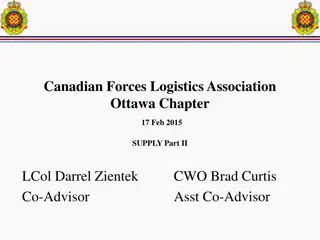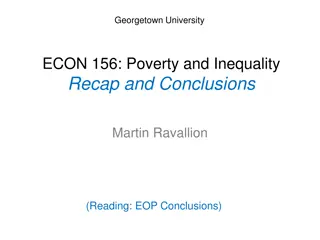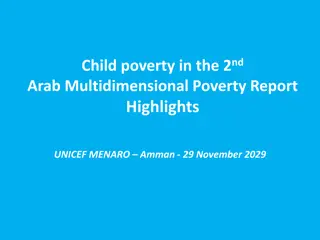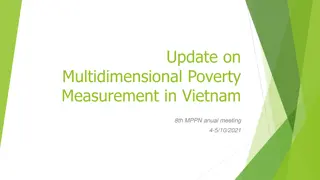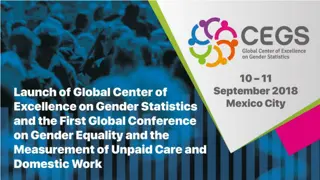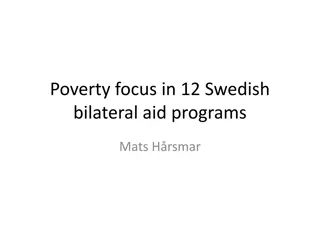Insights on Canadian Poverty Reduction Strategy Engagement
The Canadian government is dedicated to shaping a Poverty Reduction Strategy that aims to lessen poverty, track progress, and complement existing strategies. Public engagement began in February 2017, with the release of the "What We Heard" report in February 2018. The Tamarack Institute played a crucial role in facilitating community conversations. Various consultation activities, including those led by ESDC and CMHC, were undertaken to gather diverse perspectives. Key themes identified from Canadians include challenges in meeting basic needs and risks of falling into poverty.
Download Presentation

Please find below an Image/Link to download the presentation.
The content on the website is provided AS IS for your information and personal use only. It may not be sold, licensed, or shared on other websites without obtaining consent from the author. Download presentation by click this link. If you encounter any issues during the download, it is possible that the publisher has removed the file from their server.
E N D
Presentation Transcript
Poverty Reduction Strategy Engagement: What We Heard So Far
Context The Government is committed to developing a Canadian Poverty Reduction Strategy that sets targets to reduce poverty, includes a plan to measure and publicly report on progress and that aligns with and supports existing provincial/territorial/municipal strategies. Public engagement commenced February 2017 and the What We Heard report was released on February 20, 2018. 2
Release of What We Heard Report (February 20, 2018) National Poverty Conference (September 27-28, 2018) 3
Tamarack Institute was a key partner Partnered with ESDC as part of PRS consultations Leveraged their Vibrant Communities network of partner organizations to deliver 33 community conversations (in-person engagement events) Tamarack s organizational reach made them an ideal partner to connect the PRS engagement process with a wide range of views and experiences from Canadians across the country 4
Other Consultation Activities In keeping with our multi-dimensional approach on poverty, we paid close attention to consultation activities across the GoC, including: Renewal of the Aboriginal Skills and Employment Training Strategy led by ESDC National Housing Strategy led by Canada Mortgage and Housing Corporation New accessibility legislation led by ESDC The Standing Committee on Human Resources, Skills and Social Development and the Status of Persons with Disabilities study of poverty reduction ( Breaking the Cycle: Study on Poverty Reduction ) among others 5
What We Heard from Canadians Three Basic Themes: 1) Inability to Meet Basic Needs 2) Challenges with Joining the Middle Class 3) Risks of Slipping into Poverty We also heard about: 1) Uniques Experiences of First Nations, Inuit and M tis 2) Service Delivery Issues 3) Advice on Targets and Indicators 6
Theme 1: Inability to Meet Basic Needs Struggling to afford basic necessities Vital importance of providing for children s basic needs Insufficient affordable and suitable housing, and homelessness Food insecurity a particular concern for First Nations, Inuit and M tis communities Links between illness, disability and poverty The relationship between mental illness and/or addiction and poverty 7
Theme 2: Challenges with Joining the Middle Class Difficulties finding stable jobs and concerns about the changing nature of work Discrimination limiting career prospects and income for many Some youth are taking longer to join the workforce than in the past Costs of education, training and child care People living with disabilities do not always have enough access to education, training and support to participate fully in the workforce. Lack of Canadian credentials and language barriers can limit prospects of some newcomers. 8
Theme 3: Risks of Slipping into Poverty Job loss often a trigger for Canadians to fall into poverty and some youth feel insecure in precarious low-wage employment Reductions in benefits and/or social assistance seen as a disincentive to find and maintain employment. Some seniors need more support during retirement years Canadians from marginalized groups tend to have more unstable, low-wage work. Unpaid caregiving responsibilities falling disproportionately on women Women fleeing domestic violence Losing a partner can have devastating emotional and financial impacts which can lead to poverty. 9
Unique Experiences of Indigenous People We heard that certain barriers/challenges are unique to or greater for Indigenous people, and may be even more pronounced for those in northern or remote communities, women, LGBTQ and Two-Spirit people, and those with disabilities. Examples of barriers/challenges we heard about: Colonialism and racism; not enough recognition of First Nations, Inuit and M tis governments; Culturally-biased government funding; lack of training and job opportunities in communities; loss of traditional economies; high cost of living in remote communities (in particular the high cost of food); over-representation in the child welfare system, criminal justice system and homeless population; lack of basic infrastructure in certain communities; and, moving from a reserve or remote community to an urban setting. 10
Service Delivery Issues There is a lack of knowledge about federal programs and services, particularly among rural and remote First Nations, Inuit and M tis communities Applying for help can be difficult for people who are in need Information about programs and services should be more accessible and easy to understand. Multiple layers of administration and bureaucratic complexity. When accessing services in person, some Canadians feel judged and discriminated against 11
Advice on Targets and Indicators a Strategy focused on achieving real results that can be measured in precise, innovative ways. Government should be accountable for the Strategy s goals (e.g., through legislation) Current approaches to measuring poverty present challenges Existing low income measures rely on different methods and produce different results. consider multiple indicators when measuring poverty (e.g., health, housing, access to quality food) Targets should be ambitious and inspire long-term poverty reduction Short-term targets to encourage more immediate action to help those who are struggling in poverty today. 12
A foundation has already been laid for the Poverty Reduction Strategy More flexible access to EI benefits Infrastructure Investments New New EI benefit for caregivers ELCC Investments for Frameworks and agreements Indigenous People GIS Canada Child Benefit enhancements Canada Workers Benefit Enhanced Student Grants/ Loans CPP New Indigenous Skills and Emp. Training Program Enhancement National Housing Strategy $$$ for home care and mental health Skills Boost New Canada Labour Code flexibilities (EI flexibilities) 13 13
Conclusion Conversation with Canadians on poverty reduction is not over. Substantial recent progress in adressing poverty in Canada, but this is a persistent problem: roughly 1 in 10 continue to struggle to make ends meet each year. As such, reaching goals likely to require brand new ideas on top of existing programs/policies - we took stock of many innovative proposals during engagement. Setting targets and publicly measuring/reporting on progress will be key to understanding where/how GoC needs to think outside of the box . The Poverty Reduction Strategy is in development and will be released in 2018. Stay tuned! 14
